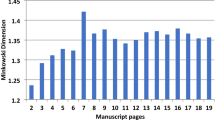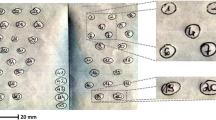Abstract
One of the tasks facing historians and preservationists is the authentication or dating of medieval manuscripts. To this end it is important to verify whether writings on the same or different manuscripts are concurrent. We propose a novel approach for the automated image-based differentiation of inks used in medieval manuscripts. We consider the problem of capturing images of manuscript pages in near-infrared (NIR) spectrum and compare the ink appearance and textural features of segmented text. We present feature descriptors that capture the variability of the visual properties of the inks in NIR based on intensity distributions of histograms and co-occurrence matrices. Our approach is novel as it is entirely image based and does not include the spectrum analysis of the inks. The method is validated by using model ink images manufactured based on known recipes and ink segmented from medieval manuscripts dated from the 11th to the 16th century. Model inks are classified by using both supervised and unsupervised clustering. Comparison of inks of unknown composition is achieved through unsupervised multi-dimensional clustering of the feature descriptors and similarity measures of derived probability density functions.
Similar content being viewed by others
References
Alexopoulou, A., & Kokla, V. (1999). Physicochemical study of inks in manuscripts using uv and ir radiation. In 6th international conference on non-destructive testing and microanalysis for diagnostics and conservation of cultural and environmental heritage (pp. 2049–2056).
Barrow, W. (1972). Manuscripts and documents. Charlottesville: University Press of Virginia.
Bishop, C. (1995). Neural networks for pattern recognition. London: Oxford University Press.
Brown, K., & Clark, R. (2004). Analysis of key anglo-saxon manuscripts (8–11th centuries) in the British library: pigment identification by Raman microscopy. Journal of Raman Spectroscopy, 35, 181–189.
Clarke, M. (2001). The analysis of medieval European manuscript. Reviews in Conservation, 2, 3–17.
Coggins, J., & Jain, A. (1985). A spatial filtering approach to texture analysis. Pattern Recognition Letters, 3, 195–203.
Dasari, H., & Bhagvati, C. (2007). Identification of non-black inks using hsv colour space. In Ninth international conference on document analysis and recognition (ICDAR 2007) (Vol. 1, pp. 486–490).
Farrokhnia, F. (1990). Multi-channel filtering techniques for texture segmentation and surface quality inspection. PhD thesis, Computer Science Department, Michigan State University.
Flieder, F., Barroso, R., & Orvezabal, C. (1975). Analysis des tannins hydrolysable susceptibles d’ entrer dans la composition des encres ferro-geliques.
Franke, K., Bunnemeyer, O., & Sy, T. (2002). Ink texture analysis for writer identification. In Eighth international workshop on frontiers in handwriting recognition (pp. 268–273).
Haralick, R. M., Shanmugam, K., & Dinstein, I. (1973). Textural features for image classification. IEEE Transactions on Systems, Man, and Cybernetics, SMC-3, 610–621.
Huang, Y., Brown, M., & Xu, D. (2008). A framework for reducing ink-bleed in old documents. In Conference on computer vision and pattern recognition (CVPR’08) (pp. 1–7).
Janssens, K., Vittiglio, G., Deraedt, I., Aerts, A., Vekemans, B., Vincze, L., Wei, F., Ryck, I. D., Schalm, O., Adams, F., Rindby, A., Knöchel, A., Simionovici, A., & Snigirev, A. (2000). Use of microscopic xrf for non-destructive analysis in art and archaeometry. X-Ray Spectrometry, 29, 73–91.
Kokla, V., Konstantinou, V., Psarrou, A., & Alexopoulou, A. (2000). Towards the creation of generalised computational models for the characterisation of inks used in byzantine manuscripts. In 15th world conference on non destructive testing (pp. 169–175).
Kokla, V., Psarrou, A., & Konstantinou, V. (2007). Ink discrimination based on co-occurrence analysis of visible and infrared images. In Proceedings of the ninth international conference on document analysis and recognition, IEEE (ICDAR’07), Curitiba, Brazil.
Lee, A., Mahon, P. J., & Creagh, D. C. (2006). Raman analysis of iron gall inks on parchment. Vibrational Spectroscopy, 41, 170–175.
Malik, J., Belongie, S., Leung, T., & Shi, J. (2001). Contour and texture analysis for image segmentation. International Journal of Computer Vision, 43(1), 7–27.
Monique, D. P. (1975). Tat des travaux effectues sur l’ analyse des consititues des encres noires manuscripts par deux technique: chromatographie sur couche mince et electrophorese (Tech. rep.). Comite pour la conservation de l’ ICOM.
Picard, R., Elfadel, I. M., & Pentland, A. P. (1991). Markov/Gibbs texture modeling: aura matrices and temperature effects. In Proceedings of the IEEE conference on computer vision and pattern recognition (pp. 371–377).
Sauvola, J., & Pietikainen, M. (2000). Adaptive document image binarization. Pattern Recognition, 33(2).
Shi, Z., & Govindaraju, V. (2004). Historical document image enhancement using background light intensity normalization. In Proceedings of the pattern recognition, 17th international conference on (ICPR’04) (Vol. 1, pp. 473–476).
Varma, M., & Zisserman, A. (2005). A statistical approach to texture classification from single images. International Journal of Computer Vision: Special Issue on Texture Analysis and Synthesis, 62(1–2), 6–81.
Zerdoun Bat-Yehouda, M. (1983). Les encres noires au moyen age (jusqu’a 1600). Paris: Editions du CNRS.
Author information
Authors and Affiliations
Corresponding author
Rights and permissions
About this article
Cite this article
Psarrou, A., Licata, A., Kokla, V. et al. Near-Infrared Ink Differentiation in Medieval Manuscripts. Int J Comput Vis 94, 136–151 (2011). https://doi.org/10.1007/s11263-011-0419-1
Received:
Accepted:
Published:
Issue Date:
DOI: https://doi.org/10.1007/s11263-011-0419-1




